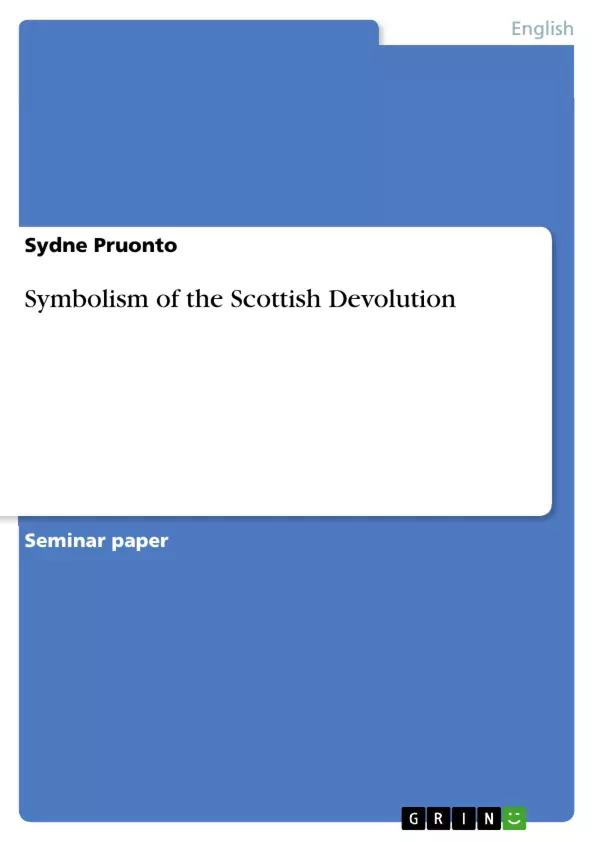Devolution has been the major political development in Scotland of the last decade. The events leading up to it and the actual process itself have been strongly underlined through the use of old symbols and the creation of new ones.
This seminar paper deals with those symbols: it will look at symbols in the awakening of a new Scottish identity, will consider the choice of buildings for a new Parliament and most importantly look at the opening of the Scottish Parliament in 1999 and 2004.
The new Scottish Parliament itself is a place of strong symbolic content- the reason why this seminar paper will focus on it as well.
Finally the paper will try to give an explanation for the importance and wide use of symbols in the process of Devolution in Scotland, showing how a modern Scottish identity is connected to the points described above.
Inhaltsverzeichnis (Table of Contents)
- I. Introduction and Background
- 1. Introduction to the topic and the contents
- 2. Devolution in Scotland- a short historic outline
- 3. Definition Symbols
- 4. Symbols in Scotland
- II. Symbolism in the Scottish Devolution
- 1. The Stone of Scone- the awakening of an identity
- a) The history of the Stone
- b) The return in 1996 and the consequences
- 2. Governmental Buildings
- a) The Old Royal High School
- b) Queensberry House
- c) Parliament Hall
- 3. The Opening of the Scottish Parliament in 1999
- 4. The New Parliament
- a) The choice for a new building
- b) The opening in 2004
- c) Sitting and layout
- d) Main Hall, sculptures
- e) debating chamber
- 5. The Saltire and other flags
- 1. The Stone of Scone- the awakening of an identity
- III. Resume
Zielsetzung und Themenschwerpunkte (Objectives and Key Themes)
This paper explores the symbolism surrounding the Scottish Devolution, analyzing how symbols played a role in the political and cultural landscape of the last century. It examines various symbols, including the Stone of Scone, governmental buildings, the opening of the Scottish Parliament, and the Saltire flag.- The significance of symbols in shaping Scottish national identity.
- The role of symbolism in the process of devolution.
- The use of symbols to express a distinct Scottish identity versus England.
- The impact of historical events on Scottish symbols and their meaning.
- The deliberate use of symbolism in the design and function of the new Scottish Parliament.
Zusammenfassung der Kapitel (Chapter Summaries)
This section provides a comprehensive overview of the key themes and arguments presented in the text. It delves into the historical context of devolution in Scotland and explores various symbols that have played a significant role in shaping Scottish identity and the devolution process.- Chapter 1: Introduction and Background - This chapter introduces the topic of Scottish Devolution and its symbolism. It provides a brief historical overview of devolution in Scotland, outlining the key events and factors that led to the establishment of the Scottish Parliament. The chapter also defines the concept of symbols and explores their role in shaping national identity.
- Chapter 2: Symbolism in the Scottish Devolution - This chapter dives deeper into the symbolism surrounding the Scottish Devolution, examining several key symbols. It begins by discussing the Stone of Scone and its historical significance, tracing its journey from Scotland to England and back again. The chapter also explores the symbolism embedded in various government buildings associated with the devolution process, highlighting their meaning for the Scottish people.
Schlüsselwörter (Keywords)
Key terms and concepts central to this analysis include Scottish Devolution, national identity, symbolism, the Stone of Scone, governmental buildings, the Scottish Parliament, the Saltire flag, and the historical relationship between Scotland and England. These themes illuminate the intricate connection between symbols and the evolution of Scottish self-governance.- Arbeit zitieren
- Sydne Pruonto (Autor:in), 2005, Symbolism of the Scottish Devolution, München, GRIN Verlag, https://www.grin.com/document/73715



